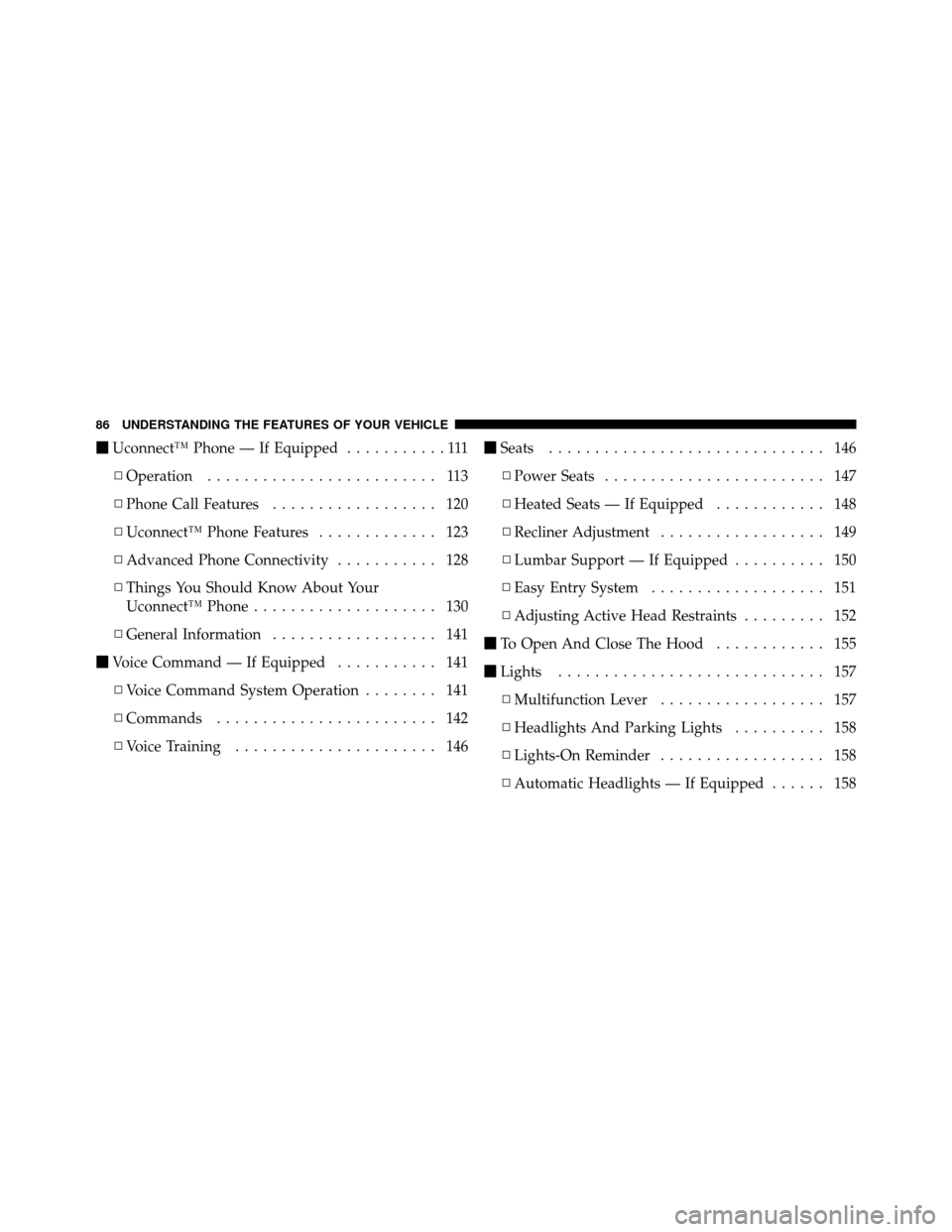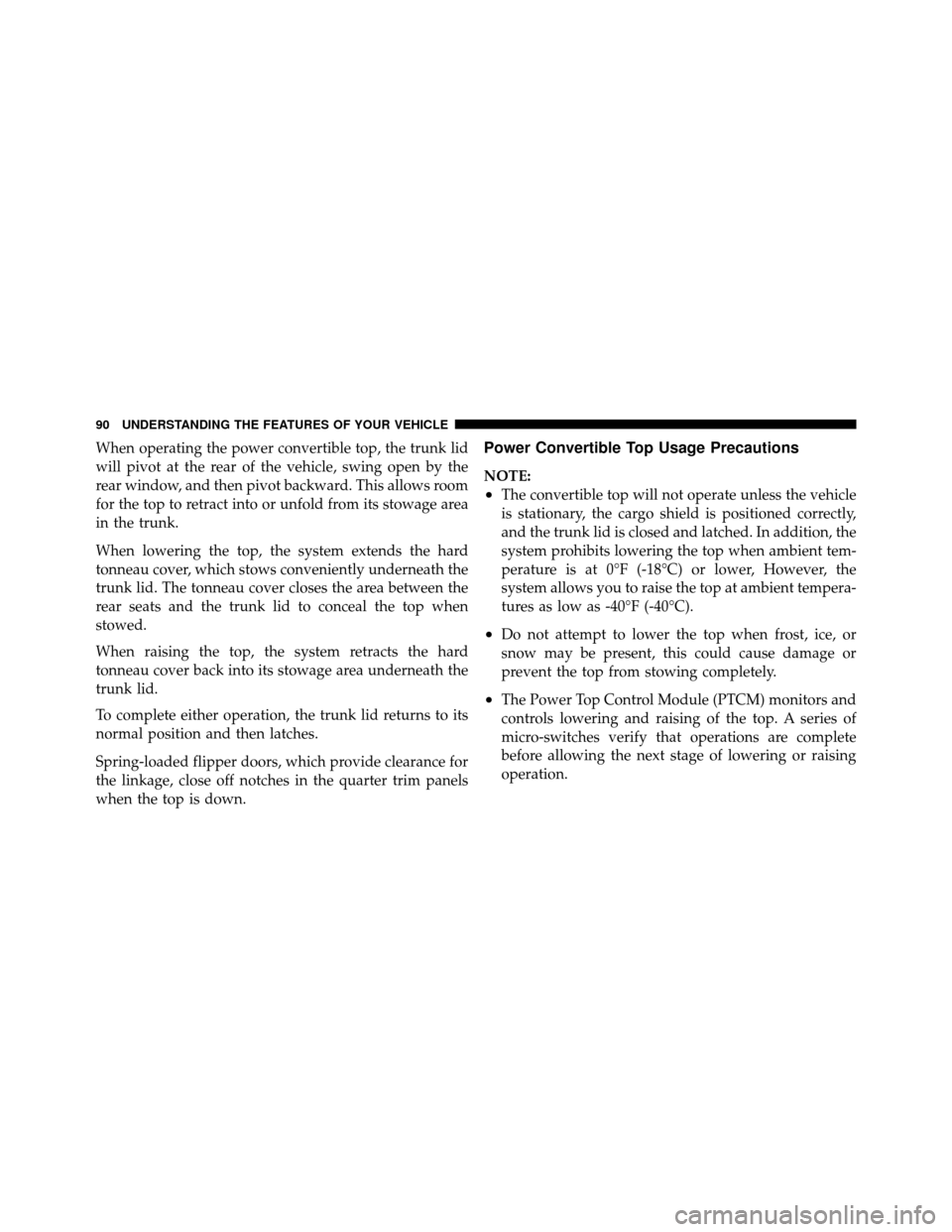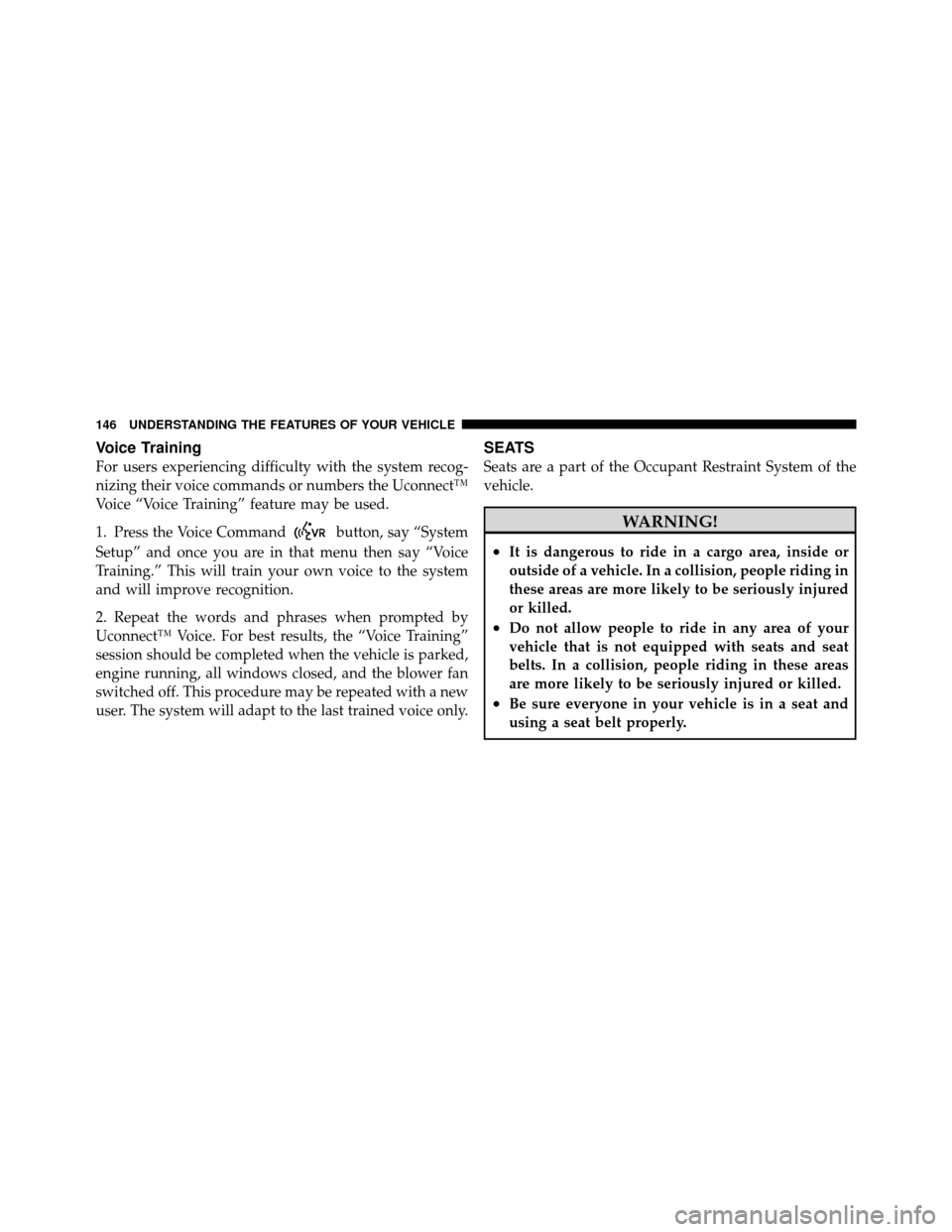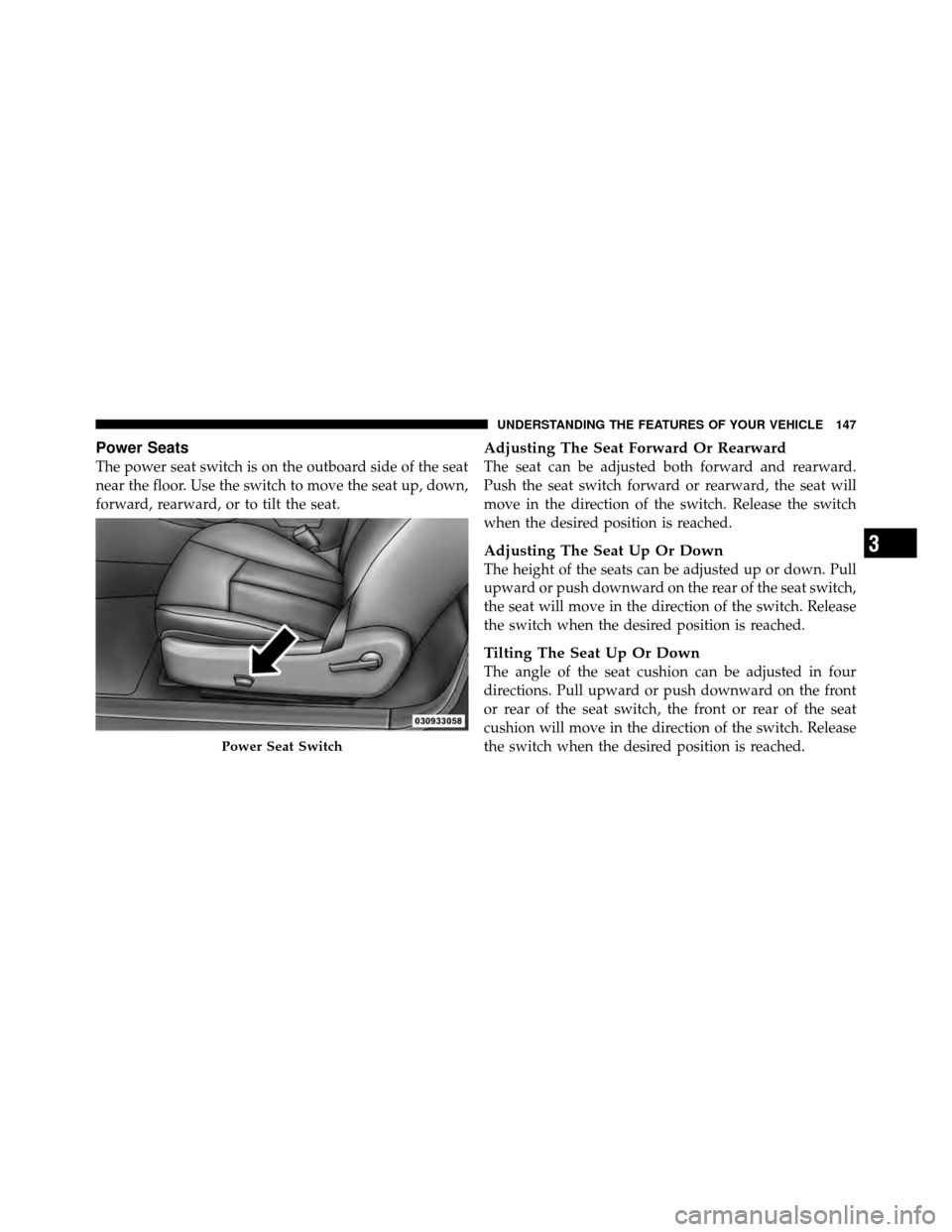Page 73 of 505

you make sure that you can install the child restraint in
the vehicle where you will use it, before you buy it.
•The restraint must be appropriate for your child’s
weight and height. Check the label on the restraint for
weight and height limits.
•Carefully follow the instructions that come with the
restraint. If you install the restraint improperly, it may
not work when you need it.
•All passenger seating positions contain automatic
locking retractors. However, any seat belt system will
loosen with time, so check the belt occasionally and
pull it tight if necessary.
•Buckle the child into the seat according to the child
restraint manufacturer’s directions.
WARNING!
When your child restraint is not in use, secure it in
the vehicle with the seat belt or remove it from the
vehicle. Do not leave it loose in the vehicle. In a
sudden stop or accident, it could strike the occupants
or seatbacks and cause serious personal injury.
Lower Anchors and Tether for CHildren (LATCH)
Your vehicle is equipped with the child restraint anchor-
age system called LATCH. The LATCH system provides
for the installation of the child restraint without using the
vehicle’s seat belts. The two rear seating positions have
lower anchorages that are capable of accommodating
LATCH-compatible child seats having flexible, webbing-
mounted lower attachments or fixed lower attachments.
Regardless of the specific type of lower attachment, never
install LATCH-compatible child seats such that two seats
share a common lower anchorage. If you are installing
2
THINGS TO KNOW BEFORE STARTING YOUR VEHICLE 71
Page 81 of 505
A new engine may consume some oil during its first few
thousand miles (kilometers) of operation. This should be
considered a normal part of the break-in and not inter-
preted as an indication of difficulty.
SAFETY TIPS
Transporting Passengers
NEVER TRANSPORT PASSENGERS IN THE CARGO
AREA.
WARNING!
•Do not leave children or animals inside parked
vehicles in hot weather. Interior heat build-up may
cause serious injury or death.(Continued)
WARNING! (Continued)
•It is extremely dangerous to ride in a cargo area,
inside or outside of a vehicle. In a collision, people
riding in these areas are more likely to be seri-
ously injured or killed.
•Do not allow people to ride in any area of your
vehicle that is not equipped with seats and seat
belts.
•Be sure everyone in your vehicle is in a seat and
using a seat belt properly.
2
THINGS TO KNOW BEFORE STARTING YOUR VEHICLE 79
Page 88 of 505

�Uconnect™ Phone — If Equipped ...........111
▫ Operation ......................... 113
▫ Phone Call Features .................. 120
▫ Uconnect™ Phone Features ............. 123
▫ Advanced Phone Connectivity ........... 128
▫ Things You Should Know About Your
Uconnect™ Phone .................... 130
▫ General Information .................. 141
� Voice Command — If Equipped ........... 141
▫ Voice Command System Operation ........ 141
▫ Commands ........................ 142
▫ Voice Training ...................... 146 �
Seats .............................. 146
▫ Power Seats ........................ 147
▫ Heated Seats — If Equipped ............ 148
▫ Recliner Adjustment .................. 149
▫ Lumbar Support — If Equipped .......... 150
▫ Easy Entry System ................... 151
▫ Adjusting Active Head Restraints ......... 152
� To Open And Close The Hood ............ 155
� Lights ............................. 157
▫ Multifunction Lever .................. 157
▫ Headlights And Parking Lights .......... 158
▫ Lights-On Reminder .................. 158
▫ Automatic Headlights — If Equipped ...... 158
86 UNDERSTANDING THE FEATURES OF YOUR VEHICLE
Page 92 of 505

When operating the power convertible top, the trunk lid
will pivot at the rear of the vehicle, swing open by the
rear window, and then pivot backward. This allows room
for the top to retract into or unfold from its stowage area
in the trunk.
When lowering the top, the system extends the hard
tonneau cover, which stows conveniently underneath the
trunk lid. The tonneau cover closes the area between the
rear seats and the trunk lid to conceal the top when
stowed.
When raising the top, the system retracts the hard
tonneau cover back into its stowage area underneath the
trunk lid.
To complete either operation, the trunk lid returns to its
normal position and then latches.
Spring-loaded flipper doors, which provide clearance for
the linkage, close off notches in the quarter trim panels
when the top is down.Power Convertible Top Usage Precautions
NOTE:
•The convertible top will not operate unless the vehicle
is stationary, the cargo shield is positioned correctly,
and the trunk lid is closed and latched. In addition, the
system prohibits lowering the top when ambient tem-
perature is at 0°F (-18°C) or lower, However, the
system allows you to raise the top at ambient tempera-
tures as low as -40°F (-40°C).
•Do not attempt to lower the top when frost, ice, or
snow may be present, this could cause damage or
prevent the top from stowing completely.
•The Power Top Control Module (PTCM) monitors and
controls lowering and raising of the top. A series of
micro-switches verify that operations are complete
before allowing the next stage of lowering or raising
operation.
90 UNDERSTANDING THE FEATURES OF YOUR VEHICLE
Page 93 of 505

•Opening and closing the top consecutively without the
engine running may run the battery down.
•If a fluttering noise is heard from the rear seat belts
while driving with the top down, safely bring the
vehicle to a stop and buckle the rear seat belts over the
empty seats. This will keep tension on the seat belts
and remove the fluttering condition.
CAUTION!
•Correctly position the cargo shield in the trunk
before stowing the top. Doing so closes a switch
that allows top operation (stowing) to proceed. If
the switch is not closed, a warning message dis-
plays in the instrument cluster to notify the driver.
•Always place items carefully into the trunk.(Continued)
CAUTION! (Continued)
•Do not push items too far into the trunk, particu-
larly when the top is retracted into its stowage area
in the trunk.
•Do not use the area on top of the tonneau cover for
storage.
Failure to follow these cautions can cause damage
to the convertible top components, trunk contents,
cargo shield, and the vehicle interior.
CAUTION!
Before operating the power top:
•Always check on top of the tonneau cover area to
be sure that it is clear of debris or other items.
•Make sure the ambient temperature is above 0°F
(-18°C).(Continued)
3
UNDERSTANDING THE FEATURES OF YOUR VEHICLE 91
Page 95 of 505

CAUTION! (Continued)
•Always close the top when leaving your vehicle so
as not to leave the interior exposed to potentially
damaging outdoor conditions.
•Do not leave the top lowered for several weeks at
a time. Close it occasionally to prevent discolor-
ation in the folds of the fabric and to allow the
creases to smooth out. This is especially important
if the top was stowed when not completely dry.
Failure to follow these cautions can cause damage
to the convertible top components, trunk contents,
and the vehicle interior:
WARNING!
Failure to follow these warnings can result in injuries
that are serious or fatal to you, your passengers, and
others around you:
•Before operating the power top, make sure that no
moving parts of the convertible top can injure a
person or animal.
•Never place any extremities (hands, feet, etc.) near
the convertible top components, the upper wind-
shield area, the shelf area behind the rear seats, or
the convertible top stowage area while raising or
lowering the convertible top.
•When using the power top button on RKE trans-
mitter, if potential danger exists while lowering
the top, release the button immediately to inter-
rupt the operation.(Continued)
3
UNDERSTANDING THE FEATURES OF YOUR VEHICLE 93
Page 148 of 505

Voice Training
For users experiencing difficulty with the system recog-
nizing their voice commands or numbers the Uconnect™
Voice “Voice Training” feature may be used.
1. Press the Voice Command
button, say “System
Setup” and once you are in that menu then say “Voice
Training.” This will train your own voice to the system
and will improve recognition.
2. Repeat the words and phrases when prompted by
Uconnect™ Voice. For best results, the “Voice Training”
session should be completed when the vehicle is parked,
engine running, all windows closed, and the blower fan
switched off. This procedure may be repeated with a new
user. The system will adapt to the last trained voice only.
SEATS
Seats are a part of the Occupant Restraint System of the
vehicle.
WARNING!
•It is dangerous to ride in a cargo area, inside or
outside of a vehicle. In a collision, people riding in
these areas are more likely to be seriously injured
or killed.
•Do not allow people to ride in any area of your
vehicle that is not equipped with seats and seat
belts. In a collision, people riding in these areas
are more likely to be seriously injured or killed.
•Be sure everyone in your vehicle is in a seat and
using a seat belt properly.
146 UNDERSTANDING THE FEATURES OF YOUR VEHICLE
Page 149 of 505

Power Seats
The power seat switch is on the outboard side of the seat
near the floor. Use the switch to move the seat up, down,
forward, rearward, or to tilt the seat.
Adjusting The Seat Forward Or Rearward
The seat can be adjusted both forward and rearward.
Push the seat switch forward or rearward, the seat will
move in the direction of the switch. Release the switch
when the desired position is reached.
Adjusting The Seat Up Or Down
The height of the seats can be adjusted up or down. Pull
upward or push downward on the rear of the seat switch,
the seat will move in the direction of the switch. Release
the switch when the desired position is reached.
Tilting The Seat Up Or Down
The angle of the seat cushion can be adjusted in four
directions. Pull upward or push downward on the front
or rear of the seat switch, the front or rear of the seat
cushion will move in the direction of the switch. Release
the switch when the desired position is reached.
Power Seat Switch
3
UNDERSTANDING THE FEATURES OF YOUR VEHICLE 147